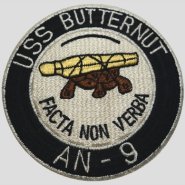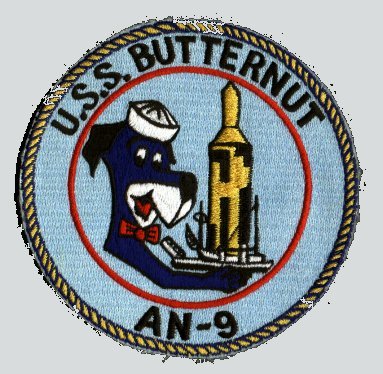Please report any broken links or trouble you might come across to the Webmaster. Please take a moment to let us know so that we can correct any problems and make your visit as enjoyable and as informative as possible.
NavSource Online: Service Ship Photo Archive


Patches Contributed by Mike Smolinski

Contributed by Al Grazevich
Butternut (YAG-60)
ex
USS Butternut (ANL-9) (1969 - 1971)
USS Butternut (AN-9) (1944 - 1969)
USS Butternut (YN-4) (1942 - 1944)
Butternut (YN-4) (1941 - 1942)
USS Butternut (AN-9) Service at the Pacific Missile Range
Contributed by Eddie Pinson
USS Butternut the matriarch of the Net Tender Fleet, in service for 30 years beginning in 1941. Here is a story from one of the hundreds's of men who served on this gallant little ship:
USS BUTTERNUT AN-9
c/o Fleet Post Office
San Francisco, California
29 July 1959
Wednesday
CHINA LAKE – USS BUTTERNUT the Navy’s first Polaris-missile service ship, is under the command of the U. S. Naval Ordnance Test Station at China Lake in the Mojave Desert.
From Long Beach Naval Shipyard – BUTTERNUT hauls the Polaris dummy out for the Pop Up tests and returns the missile afterwards for a checkup ashore. Her assignment includes hauling the 40-foot launch tube to the sea ranges towing instrument barges and mooring them in their proper places; and placing and maintaining a complex system of nets, buoys and moorings in the Pop Up area. The missile was loaded on the forecastle deck and always after dark and that is when we got underway. At the time it was a classified operation.
The U.S.S. BUTTERNUT (AN-9) is officially known as a Harbor Net Tender. She boasts an over all length of 165’, a beam of 27’ and a depth of 13’ and packs 1,000 horsepower in two diesel-electric engines working on propeller shaft. She is manned by five officers and a crew of about 50 men including seven Chief Petty Officers.
DIVING TEAM – BUTTERNUT is equipped to execute the large problems of servicing the underwater gear, with 12 of these men being qualified divers. Her Captain, LT Mike J. TRENS, USN, is a fully accredited diver and a Diving Officer as well, but this is only part of her “services rendered.”
She hauls supplies to service the floating gear, including fuel, water and has more than once brought foodstuffs for the men stationed on the island. Before mess facilities were established there, Captain TRENS hosted some 40 civilians aboard for chow in addition to his crew of 50.
CAPTAIN TRENS, having come up from the rank of Apprentice Seaman to full commissioned lieutenant, has never forgotten what he thought a ship should be. His crew has individual adjustable lights over their bunks and in the living quarters – walk on gray colored linoleum rather than a gray steel deck. Since the BUTTERNUT’s schedule is devoted to the pace of the Scientists - liberty was not routine to say the least. Nevertheless, because of the importance of their work and the resulting high morale that stems from recognition of a big job that is well done, more than one man has shipped over for BUTTERNUT duty rather than take a job offer in civilian life. LT Mike J. TRENS, USN retired not long after his duty as Commanding Officer of the BUTTERNUT. He took a job in Hawaii with a few other Mariners. While off the coast of Hawaii a ground swale came over the fantail of their small boat and the after hatch had been left open. All members went down in this accident. This is another story in itself. I have it filed away somewhere.
How well does she do her job? D. J. WILCOX, head of the Underwater Ordnance Dept. Unit supervises this San Clemente Island Polaris Pop project says of doughty BUTTERNUT – “We couldn’t get along without her.”
The indispensable ship not only services the nets and buoys, but actually has contributed to the entire operational design. Captain TRENS is a sea going “idea” man having made history at Cheatham Annex Supply Depot in Williamsburg, VA. When he eliminated a two-week job of getting up harbor defense nets with his own 48-hour plan. Captain TRENS had ideas for the Polaris problems too. Yea, how well we knew! The crew had to do it. We worked all night. In these tests, Polaris pops up out of the ocean, thus simulating firings from a submerged vessel. The dummy missile had to be prevented from falling back into the ocean and damaging its million dollar underwater launching tube. Captain TRENS suggested a method of using a net that could be pulled back away from the mouth of the launcher until firing – then immediately close over to protect the tube. This was done with the use of explosive bolts.
OTHER DUTY – BUTTERNUT provides other services too – like the time she gave medical help to two injured civilian workers. Her crew loaned stretchers, tore seats out of the chartered airplane to make room and her Hospitalman still dripping wet in his black rubber SCUBA diving suit treated the victims and accompanied them to the hospital on the beach.
The BUTTERNUT has worn a southeasterly “grove” in the sea from Long Beach to Santa Catalina’s east end – then southwesterly to San Clemente Island in her 2,000 hours of Pop Up duty, however, this course isn’t always adhered to.
On one occasion when BUTTERNUT was standing by the instrumentation barges at San Clemente Island during a storm – crane barge YN 1398 broke her moorings and drifted 50 miles nearer San Diego in a gale. With visibility near zero from hail, rescue work was not easy and the decks of the plunging barge that were three feet higher than BUTTERNUT’s rails created a hazard that mashed lifelines and air vents. The seagoing tug U.S.S. KOKA answered Captain TRENS call for assistance and spent three hours getting the YN 1398 under control. The two ships finished the job with only four miles separating them from the beach.
During another storm BUTTERNUT chased a loose barge south of the island and put two sailors aboard to secure towing lines. However, heavy seas prevented retrieving the men – so they rode out the seven hour trip back to the anchorage on the bouncing barge.
HITS THE DECK – BUTTERNUT is also the first Navy ship to be hit by a Polaris Missile and true to her “can do” tradition, BUTTERNUT survived to tell the tale. Once when the dummy missile was being loaded on board the crane rigging slipped and the Polaris missile crashed to the main deck tearing two large holes and cracking the frame. The missile program’s priority caused the Long Beach Naval Ship Yard to turn BUTTERNUT out in 48 hours much to the disappointment of her hard working crew who had anticipated at least a week lay over for repairs.
SAVING LIVES – Saving lives is not BUTTERNUT’s mission but she’s done her share. A decompression chamber is the only known remedy for the diver’s dreaded “bends.” BUTTERNUT’s dual compartment Decompression Chamber was installed to service her own crew but all men are equal when death stares them in the face.
Several commercial Abalone divers pushing their limits near San Clemente Island owe their lives to the ship’s chamber. One such “guest” remained inside under surveillance for 38 hours.
Another time with her “priority package” on board – BUTTERNUT was off Catalina’s east end changed course to aid a sinking fishing boat – getting there just in time with portable pumps and a salvage crew aboard. In short order the fishing boat was dry and engines and pumps working properly again. BUTTERNUT went back to work taking this extra curricular activity in her stride.
Keeping regular schedules is part of the BUTTERNUT’s plan but the best-laid plans can fail. Once she had to heave-to all night in pea soup fog at the harbor’s entrance. The next morning despite a very near miss in the fog bound traffic she managed to get her “priority Load” safely to the dock.
We had just entered the Breakwater and made the left turn towards our pier – I was on the Forecastle with a hand held Fender – the fog was oh so thick. I could hear voices but I couldn’t see anyone until I looked straight up in the air. There were two men looking down at me from the bow of their civilian ship. Captain TRENS hollered down at me – get out of their PINSON just as I felt the BUTTERNUT start to quiver and back down. We missed by about 6” on that one.
But fog and storms are not enough to stop the industrious little BUTTERNUT for long and the Navy’s priority Polaris Missile Program continues under full steam at San Clemente Island.
I am not absolutely positive but I have a picture with the ship’s seal dated 14 April 1960. I do believe that this was the first successful firing of the Polaris Missile.
These are some of the notes that I kept as a Yeoman striker and up until I left the BUTTERNUT in OCT 1960. My next duty station (Shore) was the USN&MCRTC in San Jose, CA.
Submitted: Eddie PINSON


